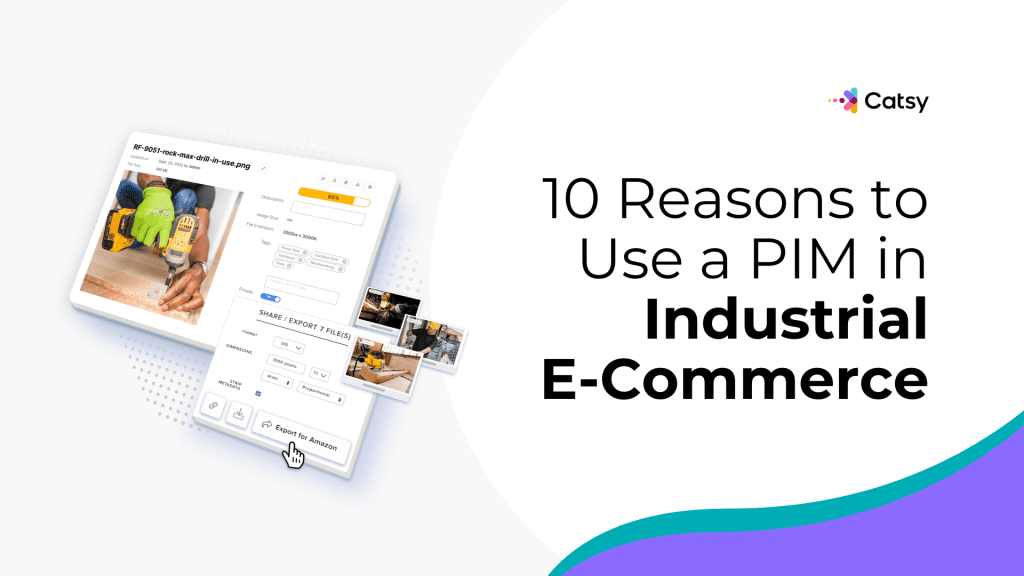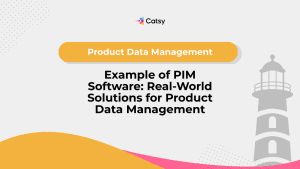10 Reasons to Use a PIM in Industrial E-Commerce
In this article, you’ll discover how a Product Information Management (PIM) system helps industrial manufacturers scale faster, sell smarter, and reduce costly errors. Plus, we invite you to download our Industrial PIM Checklist: 22 Signs You’re Ready at the end of the page.

PIM in Industrial E-Commerce
Product Information Management (PIM) might sound like a niche software acronym, but for industrial brands, it’s quickly becoming a must-have. A PIM is a centralized hub that manages all your product content—specs, images, documents, categories, and channel-specific data—so you can maintain accuracy, speed, and scale across every distribution partner.
Whether you sell air-powered tools, warehouse safety gear, electrical components, or foodservice equipment, your catalog likely includes hundreds of SKUs with variants, certifications, and usage details.
Multiply that across multiple industrial distributors (e.g. Grainger, Fastenal, Ferguson), internal systems like ERP, PLM, DAM, and manual exports to spreadsheet-based templates.
💡In fact:
- Teams without a PIM spend more than 25% of their time correcting and reformatting product data manually
- Distributors increasingly require clean, structured product content to accept and publish listings
- Mismanaged product data leads to costly launch delays, listing rejections, and order errors
This article breaks down the top 10 benefits of implementing a PIM system specifically for industrial manufacturers—from speeding up time to market to reducing errors and streamlining syndication to every endpoint your products need to reach.
In this Article
What Is a PIM System? (Quick Refresher)
A Product Information Management system is a centralized platform where all of your product content lives: specs, SKUs, descriptions, images, documents, and channel-specific attributes.
This system provides your team with a single source of truth rather than requiring them to manage numerous spreadsheets, email attachments, and separate platforms.
For industrial manufacturers, that’s a game-changer.
Whether you’re managing thousands of SKUs with complex variants or ensuring every product meets distributor compliance requirements, a PIM helps you organize, enrich, and syndicate content to your entire distribution network.
At a high level, here’s how PIM fits into your tech ecosystem:

Why a PIM in Industrial E-Commerce
matters
Industrial product data tends to be technical and messy. If you’re in this field, you’re likely managing hundreds of SKUs, each with their own specs, variants, compliance requirements, and compatibility rules.
For example: a drill might come in several voltages. A valve might need three certifications. A replacement part might only fit one model year. And all of that needs to be accurate across every channel.
Now layer on top of that:
- Custom templates for distributors like Grainger, Fastenal, and Ferguson
- PDFs, spec sheets, installation manuals, and CAD drawings
- Internal workflows between engineering, product, and marketing teams
- Strict formatting requirements
- Regulatory compliance attributes
Make Catsy DAM and PIM Software an Extension of Your Team
Book a Free Demo10 Reasons to Use a PIM in Industrial E-Commerce
1. Single Source of Truth
In B2B organizations, having inconsistent product data usually causes bottlenecks. In other words, managing content across different channels, like spreadsheets and disconnected systems, is the recipe for confusion. That’s the reason why having a PIM that unifies spec sheets, PDFs, certifications and variants is a must. It acts as a single source of truth, centralizing product information.
2. Faster Time to Market
Launching a new product it’s about getting it in front of the right buyers as soon as possible. But when content lives in disconnected tools, updates require cross-team back-and-forth, and every listing format is different, so launch timelines stretch out fast.
A PIM accelerates product launches by streamlining workflows between product, marketing, e-commerce, and operations. Everyone works from the same system, and tasks like adding specs, uploading images, and formatting listings can be done in parallel.
Businesses using PIM systems report launching products up to 75% faster; for industrial brands with seasonal demand or competitive markets, this speed means real revenue.
3. Improved Variant & SKU Management
In industrial catalogs we often see hundreds of SKUs, and handling this manually can become a nightmare. In this cases, PIM systems can make management easier. Your team can work more efficiently rather than more laboriously by applying shared information (such as compliance data or materials) across several versions.
4. Channel Syndication That is Automated
Each channel has its own peculiarities. One feed might require specific safety certifications; another might limit title lengths or reject special characters. And if you’re selling through Grainger, Fastenal, or Ferguson, every portal comes with its own template.
This is handled by a PIM, which automatically formats and maps your product data to the particular needs of each channel.
5. Better Collaboration Across Departments
In most industrial companies, product content touches nearly every team, from the engineering department to marketing and sales. That’s why PIM systems offer an unified platform where all departments may collaborate with user roles, version history, and real-time updates.
6. Analytics & Performance Insights
Understanding the performance of the content is just as important as managing it. PIM systems allow to track product data, monitor listing status across channels, and identify process bottlenecks. This allows teams to make quicker decisions.
7. Improved Data Confidence for Distributors & Internal Teams
Inconsistent or outdated data could create friction with your internal teams and distributor partners, causing delays, incorrect orders, or costly back-and-forth.
A PIM system, like Catsy, lets you update your product information in one place, then automatically syncing it everywhere.
8. Boosted Search and Filter Performance
Your buyers may be purchasing on distributor portals, but search still matters. If your product titles, bullet points, and specs aren’t structured properly, buyers won’t find your product.
Creating richer, SEO-friendly material for each listing is made simpler with a PIM. Every SKU is optimized for search engines and on-site filters thanks to centralized metadata, keyword fields, and content templates.
9. Regulatory & Compliance Control
Industrial brands are subject to rigorous compliance standards. A PIM can help you manage and validate compliance data more precisely. This system offers traceability, and role-based access guarantees that the appropriate teams retain control.
10. Scalable Operations
As your product catalog grows, so do the complexities that come with it: more SKUs, more data, more sales channels.
Without a solid system in place, that sometimes means more manual work and a higher risk of errors. A PIM allows you to create efficient, repeatable processes that make scaling easier and more sustainable. You can add new products, launch into new markets, and onboard additional distributors—without overwhelming your team or sacrificing accuracy.
Is a PIM Right for You?: Download Our Checklist and Find out
Not every company needs a PIM on day one—but if your business is growing, your product data complexity probably is too.
Enter your email, download the PDF and check out if you are ready for a PIM.
Real-World Results from PIM Implementation
Managing industrial product content doesn’t have to be a bottleneck
With a Product Information Management (PIM) system, you can centralize your data, reduce costly errors, speed up time to market, and scale across every industrial distributor and internal channel without burning out your team.
Learn how Catsy Product Information Management Software helps you win, improve speed to market, get consistent across distributor endpoints, and boost agility with automation.
👉 Want to see how Catsy helps industrial teams streamline product content? Book a demo now.
Want more tips, tutorials, and insights on product content and e-commerce operations?
Stay connected. We post regularly to help brands like yours scale smarter.
Are You Ready To streamline your product content management?

Frequently Asked Questions
They include technical specifications, product descriptions, pricing, categorization data, product codes, product relationships (kits, accessories, etc.), regulatory/compliance data, product marketing content, rich media assets like images, videos, and 3D models, product documentation like manuals, and digital product renditions for e-commerce. Having a single source of truth for all this data prevents issues when distributing it to partners.
Inaccurate or incomplete product data flowing to distributors frequently leads to negative customer experiences in a few key ways: orders getting fulfilled with the wrong products, delays on orders, components missing from product bundles, sales staff’s inability to correctly market features, and customer returns and refunds due to products not matching expectations set by the product data. Customers get frustrated when their orders don’t match what was represented.
Industrial products are inherently complex, and the number of technical attributes that need to be accurately detailed is exponentially greater. There are complex specifications, product configurations, compatibility data, industrial certifications, product documentation, and more to account for. Any misstep in data accuracy could violate safety regulations or cause products to be unusable for their intended purposes. The room for error is far less.
Complete and accurate product data is essential for distributors to forecast demand correctly and set stocking levels to avoid stockouts or overstocks. They rely on data like product descriptions, pricing, product bundling details, and other marketing data to gauge customer demand. If crucial data elements are missing or wrong, it can completely throw off their sales projections and inventory planning. This leads to carrying costs or lost sales from not having the right products available.
A PIM centralizes and validates the core product details like technical specifications, descriptions, categories, etc. DAM software does the same for product-related media like photos, videos, documents, etc. When integrated, users can quickly map assets to corresponding product details in PIM to create enriched product experiences. This high-quality product data can be distributed to sales and marketing channels like distributor portals. The tight integration ensures consistent, high-quality product data and assets.
Subscribe For More Content
Sign up for monthly tips on how to drive revenue with product content.




